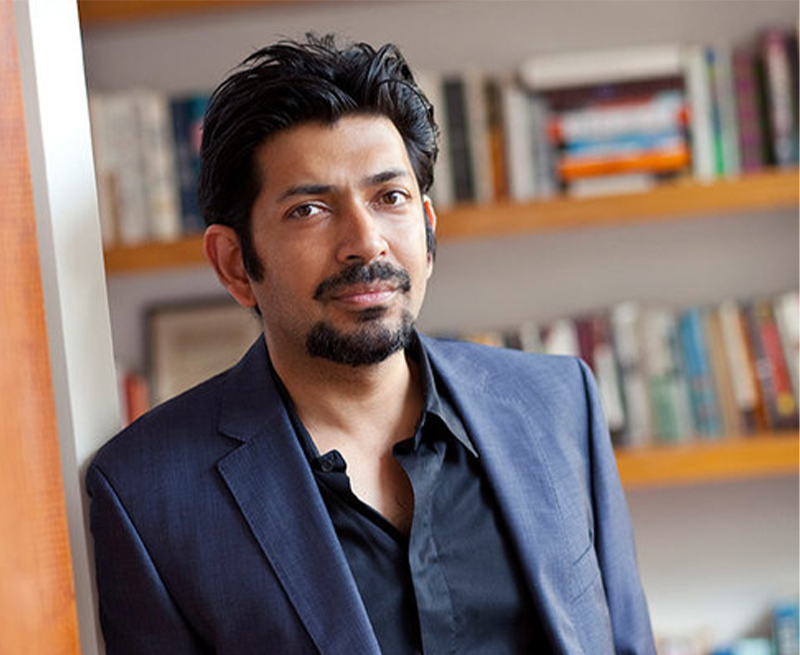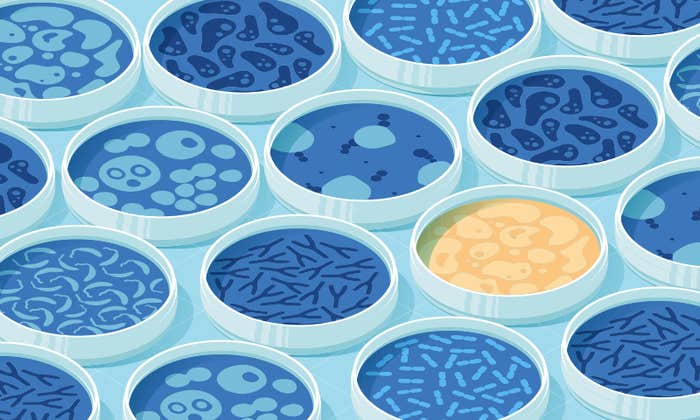During a “mid-pandemic limbo,” Siddhartha Mukherjee decided to build his own microscope. He had to see what the 17th-century Dutch cloth merchant Antonie van Leeuwenhoek saw when he looked at a raindrop under one of his self-built microscopes and found tiny creatures he called “animalcules.” Simply writing about the founder of microbiology in his new book, The Song of the Cell: An Exploration of Medicine and the New Human, wasn’t enough. After scrapping dozens of prototypes, he finally constructed a workable contraption. Mukherjee—a Pulitzer Prize-winning author, medical oncologist, and associate professor of medicine at Columbia University—used his homemade device to glimpse cells in a drop of rainwater. “The drop came sharply into view,” he writes in The Song of the Cell, “and then a whole world within it.”
The Song of the Cell, out on October 25, is Mukherjee’s fourth book. His first book, The Emperor of All Maladies: A Biography of Cancer, won the 2011 Pulitzer Prize in General Nonfiction as well as the Guardian First Book award. The renowned filmmaker Ken Burns adapted The Emperor of All Maladies into a documentary, and when Mukherjee wrote The Gene: An Intimate History, in 2016, Burns adapted that, too. When he’s not writing stories for The New Yorker, Mukherjee works clinically and conducts research in cancer cell biology and treatment, including ongoing clinical trials examining how dietary management may play a role in cancer care.
So naturally our conversation ranged widely over Mukherjee’s many occupations. Sporting a head of tousled hair and a slightly unbuttoned black shirt, he spoke to me over Zoom about how his new book explores, in a series of scientific, historical, and personal narratives, the role cells play as a primary element of life. We also discuss what motivated him to train his attention on cells, the relationship between lowbrow tinkering and highbrow science, whether science writing is a form of literature, the limits of cancer genetics, the impact his popular writing has had on his colleagues, and how often it is that useful scientific ideas come up informally and spontaneously at the dinner table.

How did you decide that cells would be the focus of your new book?
From The Gene onward, I’ve been thinking more and more about how to move upward—and by upward I mean from a more reductive approach to a more holistic approach. The gene and DNA have been iconographic elements of ourselves for a century. But a gene is lifeless without a cell. It’s a molecule. It’s the cell that allows the integration of information, that emerges from the genome and integrates that information to create function. And function is the basis of physiology.
The cell is many machines. The first thing is that it’s an information-decoding machine. The second is that it’s an information-integrating machine. And then it’s a dividing machine. It integrates information, divides, and perpetuates that so that you can form a multicellular organism.
And the time had come to pan back even more beyond that iconographic description of human beings as an agglomeration of genes and DNA, to what we really are, which is agglomerations of cells, which interpret DNA, integrate signals, and create everything that’s functional about ourselves, our metabolics and our capacities.
So I’m climbing toward a more accurate and complete description of human biology and human physiology. I draw from Rudolf Virchow’s statement that until you understand this all this way upward, you will never be able to locate or understand the locus of disease. And if you can’t understand the locus of disease, you will always be behind in your understanding of how to cure, treat, or prevent it.
You tell us that statement by Virchow is pinned to a board in your office. “Every disease depends on an alteration of a larger or smaller number of cellular units in the living body, every pathological disturbance, every therapeutic effect, finds its ultimate explanation only when it’s possible to designate the specific living cellular elements involved.”
Cancer is one example of this. We’ve been somewhat monomaniacally focused on cancer genetics, which has a very important place in all of this. But cancer isn’t just mutated genes. There is a cell biology, there’s a cell behind it, and there’s a human beyond that cell. And there are mysteries of cancer that you cannot solve by decoding the cancer genome. Why the spleen isn’t a site of metastases, whereas the liver—which is just next to it, is the same size, has the same flux of blood—is among the most frequently cited metastases. There’s nothing in the genome, as far as I can tell, that will tell you that by reading the code, and yet that question is of great clinical importance. There’s nothing in the genome, that I can read at least, or we can read now, that tells you how a brain figures out its multiple functions—regulation, sentience, cognizance. The answer lies somewhere in cell biology and maybe beyond cell biology.
It’s wonderful we know so much about genetics. But there is a post-genetic world. Which brings me back to the word “holism.” I mean the word holism very carefully. I mean that we need to integrate all the information that we’ve gathered from genetics, from ecology, from other kinds of biological investigation. It’s only when we integrate that information that we can understand how the human body is built in normalcy, and how the human body goes wrong in the context of illness.
DNA has been our iconographic element. But a gene is lifeless without a cell.
The Song of the Cell progresses from an understanding of the cell as a building block to examining what they construct, such as organs, tissues, and blood. What’s important about this concept of no cell being an island?
It’s structurally organized in a very unusual way. When you write about medicine, chronology is your friend. And you write a story chronologically because you can. These discoveries follow on discoveries, and then there’s a kind of intellectual chronology that you can construct.
But this book is organized differently. In every chapter there’s a historical prelude, and there is a future postlude or interlude. But in the middle, every chapter builds on some property that is acquired by cells and systems of cells. That is my broad takeaway message. The cell in its environment becomes a unit, acts as a unit, but also acts in collaboration and cooperation with other cells to create physiology, to create the things that we find so magical and fantastical about organisms. And as you get deeper and deeper into it, you begin to realize what a fantastic thing there is in this integrating machine.
You’ve written articles in The New Yorker touching on this theme in different ways. Did they lead to The Song of the Cell?
Yes. When I wrote a piece about cellular therapy, I kept coming back to the idea that it was the cell that was the integrator of all this physiology. And so that’s where I began to really think about the cell as that master integrator, and cell-cell interactions as the basis of physiology. I began to think about the future and the new human. You have people who are being infused with modified cells, altered cells, cells whose behaviors we’ve changed, cells whose physiologies we’ve changed in order to effect new ways of thinking about cancer. So in terms of medicine describing human life, it felt as if all of these were pointing to the same direction, which is the direction of the cell.
If you’re moving up the ladder of complexity, what’s the next rung?
That rung is metabolism, integration, and potentially behavior. And how understanding those, how cells interact with each other, and how, at the largest level, how humans interact with each other, will perhaps be the last of these rungs. Gene-cell-environment-behavior would be the last step. Dissecting that last piece is going to be the hardest because it’s the least known. Questions like why, even after we know that smoking cessation causes enormous health benefits, can we not get half the world to stop smoking? Obviously, there’s an addictive component to that. But there are social components to that. There are network effects in that. Same for metabolism—metabolism isn’t something that happens as a consequence of one gene.
Writing is a mechanism to understand and express ideas. I write to think.
You write, “Highbrow science was born from lowbrow tinkering.” Is there still a place for lowbrow tinkering in the practice of modern science?
For me, it’s very much about beginning with very lowbrow things, just looking at cells, looking at how they interact. The first experiments that I design when I design a new experiment are usually extraordinarily simple. Let’s put this and this together and see what happens. And then we go into much more complex things like data analysis, genomics, and proteomics. But it’s not as if I’m coming home and thinking, Oh gosh, let’s apply proteomics to this cell. What I’m coming home thinking is something very simple, like how can we genetically manipulate an immune cell to make a cell that becomes super phagocytic? We’re studying bone a lot. What does it look like? What does an arthritic bone look like under the microscope? That’s where I begin all my experiments. As a cell biologist or virologist, I begin just by looking. And the first thing I do is try to see, what is it about these things? What is special? What’s different? And, how can I manipulate it if I can? And what will be the result of manipulating any of this?
You might argue that there’s still a seamless transition from dinner table conversation to actual work going on in the laboratory.
It’s very important to have that dinner table conversation. That’s why scientists still meet in person. There’s a saying that most of the best science in the meetings is done off the meetings. That’s when people really begin to think about ideas and collaborations, that wheels begin to turn. It’s certainly been true for me.
Faeth, a company that I launched with Lew Cantley, which uses metabolism as a mechanism to deal with cancer, was launched because we’re out to dinner and Lew took a paper napkin, and started drawing. And we were drawing together. It’s not like Lew said to me, “Gosh, you know, I’ve done this massive transcriptomic blah, blah, blah, blah, blah, on cells. And I think that this is the case.” It was just a doodle. We did experiments after that. We started with simple experiments, went on to very complex experiments, and finally went on to do transcriptional analysis and find mechanisms and so forth. Again, different scientists are different. But for me it begins at a very simple place.
The golden goal is always going to be, “How can we alleviate suffering?”
How do you understand your role as a science communicator?
In some ways, I don’t think of myself as a science communicator, although of course I am. I like communicating about science. I think of myself as someone who tries to describe the process. And of course, that’s a form of communication—it would be silly to say that it was not—but I try to describe the process. And the hope is that in describing the process, I capture something about the way science is done, the human affair of it—the frustrations of it, but also the wonder of it—in a way that you couldn’t do otherwise. It’s not like I sit down and say, “I’m going to communicate this idea.” It’s more like, “Here’s something that I’m very excited about. And if I’m very excited about it, I’m pretty sure other people will be, too.” I can’t write about things that I myself am not excited about. That is the source and the beginning and the end of how I write.
Does your popular writing affect your relationships with research colleagues?
Virtually all my research colleagues know about my second, secret life, as it were. I collaborate heavily with people like Jim Manley on RNA, with Lew Cantley on metabolics, with physicians like Azra Raza on acute myeloid leukemia and myelodysplastic syndromes, with a whole team of people working on chimeric antigen receptor T-cell therapies in India. They all know about what I do in this other life. And they are respectful of it, but it somehow doesn’t enter the conversation because when we’re talking about the science, we’re talking about the science. And they know that somehow maybe they’ll end up in a book somewhere. And they are almost always fine with it.
In your chapter on in vitro fertilization, you talk about Landrum Shettles, a professor of obstetrics and gynecology at Columbia University, who neglects to tell his department about his plans to create a human embryo in vitro for implantation. Why do you describe him as “tone-deaf to the scientific and moral crossings required to produce a human embryo in a glass jar?”
In medicine, the golden goal is always going to be, “How can we alleviate suffering?” And what is suffering? What does suffering mean? In science, of course, the ultimate goal is also to alleviate human suffering, but it also includes understanding nature. But then, in the middle of understanding nature, we very quickly make a crossing into tampering with nature, and what is natural. And that’s where I think there requires a lot of acuity in non-tone-deafness, so that we can understand nature, but also understand where we stop tampering with nature so that we don’t get into deeper trouble.
Do you think science writing can be considered literature?
I don’t really make a distinction between “big L” literature and writing about science. If you read Leonardo’s books, or if you read Lewis Thomas or others, you’ll quickly realize that that distinction is an arbitrary distinction. They were writing as much literature as the next person. So I think there’s no “big L” literature. Writing is writing. Writing is a mechanism for us to understand and express ideas. I write to think.
How do you construct a story? What does a story mean? Where do pieces of a story fit in? How do you not give away the punchline before a certain point? How do you build a sense of wonder, a sense of suspense, a sense of achievement or failure? Those ideas cross all boundaries of disciplines. So I think of literature as just a mechanism—as I said, I’m a big reader, I love to read—to cross those boundaries. ![]()
Michael Denham is a medical student at the Columbia University Vagelos College of Physicians and Surgeons. Follow him on Twitter @MichaelWDenham.
Lead image: Vilmos Varga / Shutterstock


























